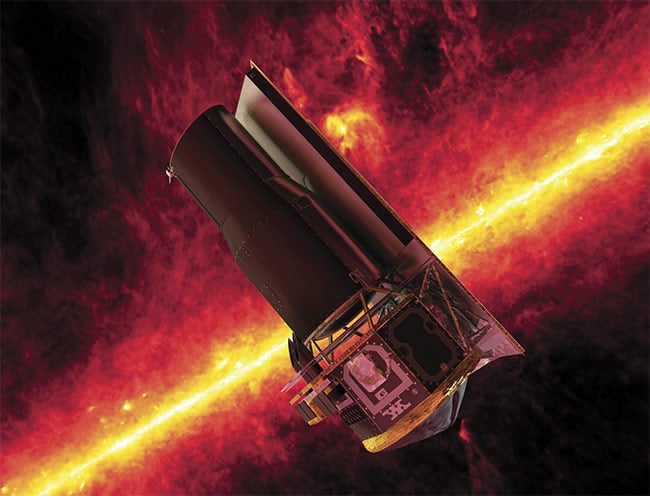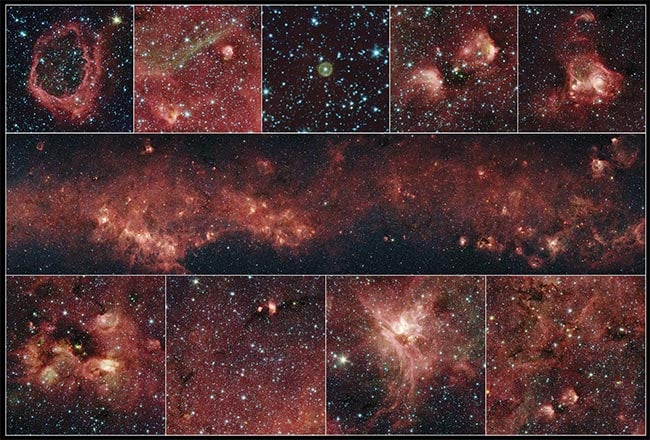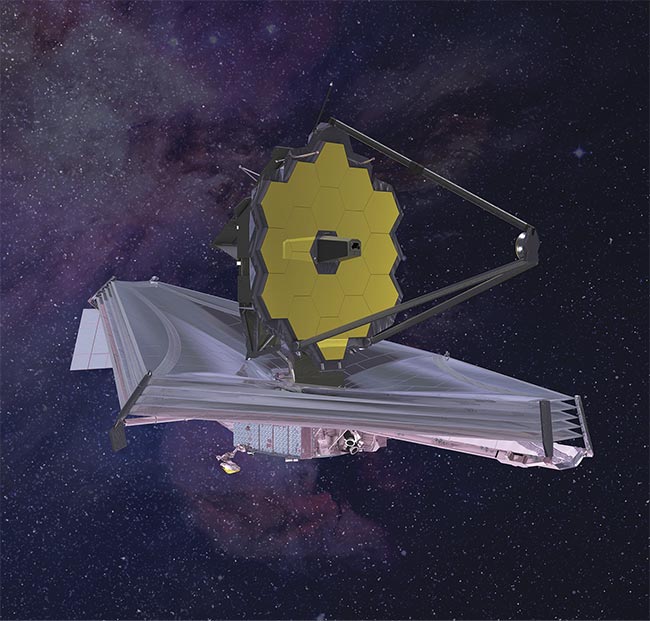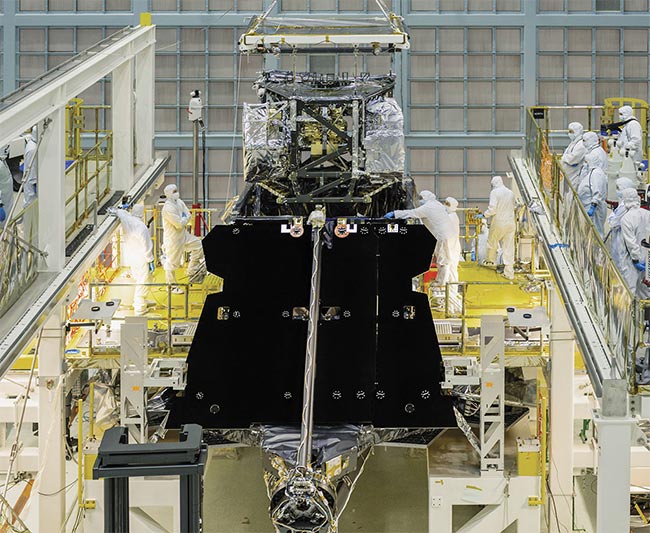As space telescopes go through upgrades, larger detector arrays that offer improved sensitivity and reduced noise will benefit a range of research and defense applications.
FAROOQ AHMED, CONTRIBUTING EDITOR
August 25 marked the Spitzer Space Telescope’s “sweet 16.” Launched in 2003 with a planned primary mission of 2.5 to 5 years, the infrared observatory — the last of NASA’s
Great Observatories to take flight — far outlasted its initial mandate, depleting its store of liquid helium coolant and transitioning into a “warm mission” in 2009 (Figure 1).

Figure 1. The Spitzer Space Telescope seen against the IR sky. The band of light is the glowing dust emission from the Milky Way galaxy seen at 100 µm (as seen by the IRAS and COBE missions). Courtesy of NASA/JPL-Caltech.
In their recent book on Spitzer, More Things in the Heavens: How Infrared Astronomy Is Expanding Our View of the Universe, Michael Werner, the lead scientist for Spitzer, and Peter Eisenhardt, a senior research scientist at NASA’s Jet Propulsion Laboratory, detail Spitzer’s numerous contributions to astronomy. These include: a better understanding of the Earth-size planets in the TRAPPIST-1 system; the detection of so-called big baby galaxies (newly formed galaxies larger than astronomers thought possible); the most extensive map of the Milky Way from the Galactic Legacy Mid-Plane Survey Extraordinaire (GLIMPSE 360) project; and details of the Helix Nebula, the colorful remains of a sun-like star almost 700 light-years from Earth, among dozens of other discoveries1.
Spitzer is not the first craft to detect IR wavelengths in space. It was preceded by the Infrared Astronomical Satellite, which launched in 1983, and the European Space Agency’s Infrared Space Observatory, which launched in 1995. However, the
advancements made in instrumentation during Spitzer’s development (which allowed for a more than thousandfold increase in the number of pixels per detector, for example) and the results produced by those advancements underscore the need to work in this spectrum in space (Figure 2). As Werner and Eisenhardt note in their book, “The infrared portion of the spectrum stands at the forefront of modern astrophysical research.”

Figure 2. In this panoramic image from the GLIMPSE 360 project (center row), a plethora of stellar activity in the Milky Way’s galactic plane, reaching to the far side of our galaxy, is exposed. This image spans 9° of sky. The red clouds indicate the presence of large organic molecules that have been illuminated by nearby star formation. The patches of black are dense, obscuring dust clouds. The IR images were captured with Spitzer’s IRAC. Courtesy of NASA/JPL-Caltech.
There are two primary reasons that this is the case, according to Giovanni Fazio, a senior physicist at the Harvard-Smithsonian Center for Astrophysics: “As the universe expands, objects in space move away from us. The visible light they emit gets stretched — it redshifts into the infrared. Therefore, to observe objects in the early universe, we need to observe in the infrared. And infrared wavelengths can penetrate through dust and other obscuring phenomenon — particularly around forming stars.” In August, Fazio received SPIE’s George W. Goddard Award in Space and Airborne Optics at the SPIE Optics + Photonics conference in San Diego.
IR arrays were originally developed by the U.S. Department of Defense (DOD) for missile tracking. “Initially, astronomers used surplus detectors that had to be modified for use in astronomy,” Fazio said. Spitzer carries three scientific instruments: an IR array camera (IRAC), an IR spectrograph, and a multiband imaging photometer. Fazio is the principal investigator for Spitzer’s IRAC. Only two of the IRAC’s four 256- × 256-pixel detector arrays, working at 3.6- and 4.5-µm wavelengths, remain operational in its warm mission. They are composed of indium antimonide, while the 5.8- and 8-µm wavelength detector arrays that are no longer in operation are made of arsenic-doped silicon impurity-band-conduction technology.
“Operating in space also provides benefits over ground observatories,” Fazio said. “For example, you have 100% transmission over the entire infrared spectrum, and one-millionfold decrease in background radiation.”
Before it is decommissioned in January 2020, Spitzer will use its operational IR detector arrays to continue identifying objects for the James Webb Space Telescope (JWST) to further investigate. Led by NASA and its European and Canadian space agency partners, this scientific successor to both Spitzer and the Hubble Space Telescope is currently scheduled to launch in March 2021 (Figure 3).

Figure 3. A rendering of the James Webb Space Telescope. Courtesy of Northrop Grumman.
James Webb Space Telescope
NASA’s Spitzer Space Telescope represented a generational improvement over its predecessor, the Infrared Astronomical Satellite. Similarly, the sophistication of JWST’s instruments are expected to reveal the formation of some of the earliest known galaxies, as well as underexplored details — not just the presence and location of exoplanets, but also their physical environments. JWST has a planned primary mission duration of five years, although it is fueled for more than 10.
IR arrays were originally developed by the U.S. Department of Defense for missile tracking.
JWST uses two types of detectors: mercury-cadmium-telluride H2RG detectors for the 0.6- to 5-µm NIR, made by Teledyne Imaging Sensors of Camarillo, Calif., and arsenic-doped silicon detectors for the 5- to 28-µm MIR, made by Raytheon Vision Systems of Goleta, Calif. Each H2RG NIR detector has about 4 million pixels, while the MIR detectors have about 1 million pixels each.
“The technique of epitaxial growth used to manufacture current infrared detectors produces more uniform arrays and much higher yields than the growth of the indium antimonide crystals we used on Spitzer’s IRAC,” Fazio said.
In addition, JWST’s telescope packs a 6.5-m-diameter primary mirror formed by 18 hexagonal segments, in contrast to Spitzer’s 85-cm-diameter one. (Hubble’s primary mirror is 2.4 m in diameter.)
“There is a clear vector of progress from the early [DOD] tactical infrared detectors through to the Hubble Space Telescope, Spitzer, and now JWST,”
Bernard Rauscher said. As an experimental astrophysicist, Rauscher is the
Goddard Space Flight Center detector
scientist for JWST and serves as the deputy project scientist for its Integrated Science Instrument Module (ISIM) (Figure 4).

Figure 4. The James Webb Space Telescope’s Integrated Science Instrument Module is lowered
into the telescope, which is resting facedown on the assembly stand at NASA’s Goddard Space Flight Center. Courtesy of NASA/Chris Gunn.
Hubble observes primarily in the visible and near-UV regions of the spectrum. JWST will focus on the IR region, while surpassing Spitzer’s capabilities. Rauscher said JWST’s detectors have improved sensitivity and pixel density and reduced dark count rates and readout noise. Rauscher called them “a huge advancement over anything we currently have — dramatically more aperture and larger focal plane areas.”
The scientific instruments on the ISIM include an NIR camera and spectrograph (0.6- to 5-µm wavelength detection), an MIR camera and spectrometer (5- to 27-µm wavelength detection), and an NIR imager and slitless spectrograph (0.8- to 5-µm wavelength detection). The space telescope will be placed near the second Lagrange point — a gravitational equilibrium point — of our Earth-sun system, opposite the sun. Because of its location, JWST will be cooled by a five-layer,
approximately 21- × 14-m insulating
sunshield, though it also uses a liquid
helium cryocooler for the MIR instrument. A rip in the sunshield during testing, however, forced a recent launch delay.
Terahertz future
Mona Jarrahi is a professor of electrical engineering at UCLA who primarily works in the terahertz region of the spectrum. This region is sandwiched between longer-wavelength microwaves and shorter-wavelength IR. It has been underexplored because it cannot be easily assessed by traditional electronic or
photonic means due to semiconductor
device limitations. But the “terahertz gap,” as it has been known, is shrinking. According to Jarrahi, “Both the photonic and electronic communities have been able to push the performance of their
devices, but there remain some fundamental physical limitations.”
Terahertz detectors offer valuable information for astrophysics research. Like IR wavelengths, terahertz wavelengths are long enough to pass through dust and obscuring phenomena and around forming stars. And, as Jarrahi points out,
“The terahertz region is very rich for the detection of spectral signatures of chemicals important for our understanding of astrophysics and planetary phenomena. Many molecules have unique signatures in the terahertz region. We could investigate whether exoplanets have similar environments to Earth, for example.”
In July, Jarrahi’s lab announced the
development of a terahertz detector that operates without cryogenic cooling and may be suitable for deployment on next-generation space telescopes2. Convention-
al terahertz detection techniques involve mixing terahertz frequencies with reference frequencies and downconverting them to radio frequencies to be analyzed by electronic devices. Jarrahi’s solution was to use a photonic mixer instead of
an electronic one (Figure 5). “The advantage is that in photonics, you don’t have a lot of the bandwidth limitations that electronic devices have.”

Figure 5. A photograph and electron microscope image of the terahertz detector
developed by Mona Jarrahi’s team at UCLA. Courtesy of Mona Jarrahi/UCLA.
Because Jarrahi’s detector does not require cooling, it potentially frees
spacecraft from the burden of carrying liquid helium. The Spitzer Space Telescope, for example, was placed in a heliocentric orbit as opposed to an Earth-centric one, in part to reduce the coolant required to compensate for Earth’s heat load.
Jarrahi admits that terahertz technology
is not as mature as IR technology. However, the ubiquity of terahertz signals throughout the universe, in combination with the sensitivity and scalability of her detection technology, makes it attractive.
Jarrahi is now working on deploying her
detector technology for astrophysics research. “As an engineer, I get information from astrophysicists — what kind of chemistry and physics they’re interested in — and then I build instruments around that,” she said.
Radiation hardening
NASA’s Rauscher is also working on next-generation array detectors. Also at the August SPIE Optics + Photonics conference, he detailed radiation-hardened detectors that may fly on future missions3.
“Infrared arrays are inherently radiation tolerant,” Rauscher said. “But
mercury-cadmium-telluride will be slowly damaged by radiation in space.” Instead, he has been focusing on silicon for newer detectors. “It’s very mature technology and has been used in CCDs for decades. You can achieve a quantum efficiency of up to 85% at 940 nm, which is useful for detecting water vapor.” In collaboration with scientists at Lawrence Berkeley National Laboratory, Rauscher has been developing photon counting p-channel CCDs. “The radiation hardening comes specifically from the dopant,” Rauscher said. “We use boron instead of phosphorous, which is traditionally used.”
Going dark
NASA, of course, has ambitious plans for future spacecraft. In its 2010 decadal survey, the National Research Council, convened through the National Academy of Sciences, prioritized the Wide Field Infrared Survey Telescope (WFIRST), which may be launched in the mid-2020s. Its detector arrays are currently planned to be 2048 × 2048 pixels at 2.5-µm wavelength. A former DOD telescope, WFIRST would search for dark energy and is conceptually similar to the European Space Agency’s Euclid telescope, which is scheduled to launch in 2022.
The current administration, however, has
routinely excluded WFIRST from its bud-
get, putting the future of what has been termed “NASA’s top large space mission”
in serious doubt. “Luckily, Congress keeps putting it back in the budget,” Harvard-Smithsonian’s Fazio said.
Acknowledgments
The author would like to thank Giovanni Fazio, the Harvard-Smithsonian Center for Astrophysics; Bernard Rauscher, the NASA Goddard Space Flight Center; and Mona
Jarrahi, UCLA.
References
1. M. Werner and P. Eisenhardt (2019).
More Things in the Heavens: How Infrared Astronomy Is Expanding Our View of the Universe. Princeton, N.J.: Princeton University Press.
2. N. Wang et al. (July 8, 2019). Room-
temperature heterodyne terahertz detection with quantum-level sensitivity. Nat Astron, www.doi.org/10.1038/s41550-019-0828-6.
3. B. Rauscher et al. (Sept. 9, 2019). Radiation tolerant, photon counting, visible and near-IR detectors for space coronagraphs and starshades. UV/Optical/IR Space Telescopes and Instruments: Innovative Technologies and Concepts IX. Proc SPIE, Vol. 11115, www.doi.org/10.1117/12.2536509.